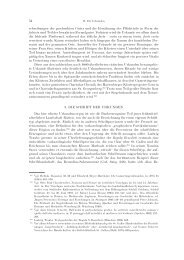Chapter Three ANTHOLOGIES AND ANTHOLOGISTS Between c ...
Chapter Three ANTHOLOGIES AND ANTHOLOGISTS Between c ...
Chapter Three ANTHOLOGIES AND ANTHOLOGISTS Between c ...
Create successful ePaper yourself
Turn your PDF publications into a flip-book with our unique Google optimized e-Paper software.
102<br />
Part One: Texts and Contexts<br />
traylep5trayloß, which is formed by analogy with the neologism<br />
óaylep5óayloß found in AP XI, 238. The early tenth-century Sylloge Euphemiana<br />
(see pp. 114–115) contains a poem by Leo, in which he derides his doctor<br />
for prescribing a regime of cold water in the middle of winter 57 . The insertion of<br />
Leo’s poem in a collection of ancient epigrams indicates, I think, that its<br />
redactor wished to pay tribute to Leo the Philosopher for his scholarly work on<br />
the Greek Anthology. Finally, the fact that two of his students, Constantine<br />
and Theophanes, published collections of erotic epigrams, strongly suggests<br />
that the Greek Anthology was one of the many scholarly pursuits to which Leo<br />
the Philosopher turned his attention.<br />
The so-called Sylloge Parisina is divided into two parts deriving from two<br />
different sources. The first part contains a selection of epigrams from Cephalas’<br />
anthology. The second part is a collection of pederastic epigrams headed by<br />
Constantine the Sicilian’s Love Song (îŸd1rion rztikön) 58 . This collection of<br />
pederastic epigrams is closely related to AP XII, one of the books of Cephalas’<br />
anthology. But since the collection contains many pederastic epigrams that<br />
cannot be found in AP XII, it appears to derive from a source other than<br />
Cephalas’ anthology 59 . This source I call PCP (Parisian Collection of Paederastica).<br />
The main difference between Cephalas and PCP is that the latter does not<br />
confuse gender, whereas Cephalas had some trouble distinguishing boys from<br />
girls and regularly misclassified erotic epigrams. Take for instance AP XI, 51<br />
and 53, which Cephalas mistakenly placed among the gnomic epigrams because<br />
he failed to understand their elusive meaning. The redactor of PCP, however,<br />
had no problem in grasping the sexual innuendo of these two epigrams and<br />
rightly recognized their pederastic nature. To give another example, Cephalas<br />
placed the famous epigram on Agathon by Ps. Plato in the heterosexual<br />
section: “I stayed my soul on my lips kissing Agathon. The rascal had come to<br />
cross over to him” (AP V, 78). This is truly a stupendous blunder. The redactor<br />
of PCP, once again, rightly judged that what we have here is one male in love<br />
with another. Given the fact that PCP contains epigrams not found in AP XII<br />
and does not present the sort of misclassifications typical of Cephalas, there<br />
can be but little doubt that it does not derive from the anthology of Cephalas.<br />
The original PCP is beyond any secure reconstruction, because the second part<br />
of the Sylloge Parisina appears to contain only a few excerpts. However, as the<br />
57 Ed. WESTERINK 1986: 200 (no. X).<br />
58 For a thorough description of the Sylloge Parisina, see CAMERON 1993: 217–245. The<br />
sylloge can be found in Par. Suppl. gr. 352 and Par. gr. 1630. For a description of these<br />
two manuscripts, see Appendix I, pp. 287–293, esp. pp. 291–292 and n. 21.<br />
59 CAMERON 1993: 224 and 238–253, on the contrary, argues that the epigrams lacking in<br />
AP XII but found in the Sylloge Parisina ultimately derive from the anthology of<br />
Cephalas. But see LAUXTERMANN 1999a: 163–164, for a refutation of Cameron’s views.




